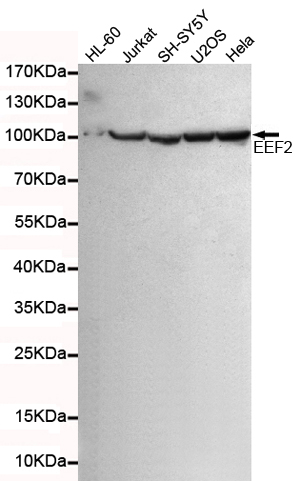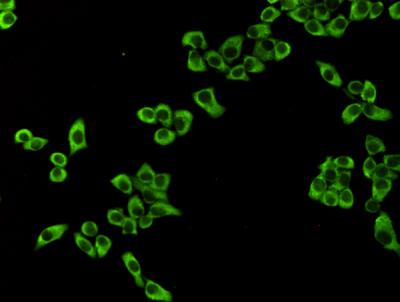eEF2 Antibody
Purified Mouse Monoclonal Antibody (Mab)
- SPECIFICATION
- CITATIONS
- PROTOCOLS
- BACKGROUND

Application
| WB, ICC |
|---|---|
| Primary Accession | P13639 |
| Reactivity | Human |
| Host | Mouse |
| Clonality | Monoclonal |
| Isotype | IgG2b |
| Calculated MW | 95 KDa |
| Gene ID | 1938 |
|---|---|
| Other Names | EEF2;Eef2;EF-2;EF2;EF2_HUMAN;Elongation factor 2;Eukaryotic translation elongation factor 2;Polypeptidyl tRNA translocase;SCA26. |
| Dilution | WB~~1:5000 ICC~~1:200 |
| Format | Liquid in PBS containing 50% glycerol, 0.5% BSA and 0.02% sodium azide, pH 7.3. |
| Storage | Store at 4°C short term. Aliquot and store at -20°C long term. Avoid freeze/thaw cycles. |
| Name | EEF2 |
|---|---|
| Synonyms | EF2 |
| Function | Catalyzes the GTP-dependent ribosomal translocation step during translation elongation (PubMed:26593721). During this step, the ribosome changes from the pre-translocational (PRE) to the post- translocational (POST) state as the newly formed A-site-bound peptidyl- tRNA and P-site-bound deacylated tRNA move to the P and E sites, respectively (PubMed:26593721). Catalyzes the coordinated movement of the two tRNA molecules, the mRNA and conformational changes in the ribosome (PubMed:26593721). |
| Cellular Location | Cytoplasm. Nucleus. Note=Phosphorylation by CSK promotes cleavage and SUMOylation-dependent nuclear translocation of the C- terminal cleavage product. |

Thousands of laboratories across the world have published research that depended on the performance of antibodies from Abcepta to advance their research. Check out links to articles that cite our products in major peer-reviewed journals, organized by research category.
info@abcepta.com, and receive a free "I Love Antibodies" mug.
Provided below are standard protocols that you may find useful for product applications.
Background
Catalyzes the GTP-dependent ribosomal translocation step during translation elongation. During this step, the ribosome changes from the pre-translocational (PRE) to the post- translocational (POST) state as the newly formed A-site-bound peptidyl-tRNA and P-site-bound deacylated tRNA move to the P and E sites, respectively. Catalyzes the coordinated movement of the two tRNA molecules, the mRNA and conformational changes in the ribosome.
References
Rapp G.,et al.Biol. Chem. Hoppe-Seyler 370:1071-1075(1989).
Hanes J.,et al.Biol. Chem. Hoppe-Seyler 373:201-204(1992).
Ustek D.,et al.Submitted (FEB-2005) to the EMBL/GenBank/DDBJ databases.
Mural R.J.,et al.Submitted (SEP-2005) to the EMBL/GenBank/DDBJ databases.
Rapp G.,et al.Biol. Chem. Hoppe-Seyler 369:247-250(1988).
If you have used an Abcepta product and would like to share how it has performed, please click on the "Submit Review" button and provide the requested information. Our staff will examine and post your review and contact you if needed.
If you have any additional inquiries please email technical services at tech@abcepta.com.













 Foundational characteristics of cancer include proliferation, angiogenesis, migration, evasion of apoptosis, and cellular immortality. Find key markers for these cellular processes and antibodies to detect them.
Foundational characteristics of cancer include proliferation, angiogenesis, migration, evasion of apoptosis, and cellular immortality. Find key markers for these cellular processes and antibodies to detect them. The SUMOplot™ Analysis Program predicts and scores sumoylation sites in your protein. SUMOylation is a post-translational modification involved in various cellular processes, such as nuclear-cytosolic transport, transcriptional regulation, apoptosis, protein stability, response to stress, and progression through the cell cycle.
The SUMOplot™ Analysis Program predicts and scores sumoylation sites in your protein. SUMOylation is a post-translational modification involved in various cellular processes, such as nuclear-cytosolic transport, transcriptional regulation, apoptosis, protein stability, response to stress, and progression through the cell cycle. The Autophagy Receptor Motif Plotter predicts and scores autophagy receptor binding sites in your protein. Identifying proteins connected to this pathway is critical to understanding the role of autophagy in physiological as well as pathological processes such as development, differentiation, neurodegenerative diseases, stress, infection, and cancer.
The Autophagy Receptor Motif Plotter predicts and scores autophagy receptor binding sites in your protein. Identifying proteins connected to this pathway is critical to understanding the role of autophagy in physiological as well as pathological processes such as development, differentiation, neurodegenerative diseases, stress, infection, and cancer.



